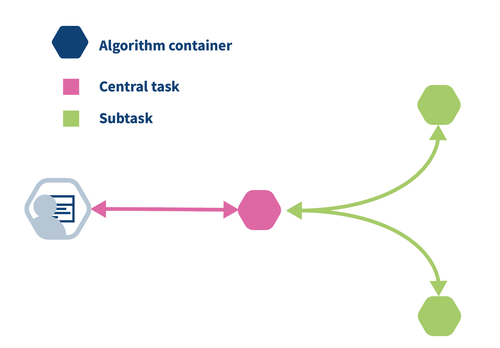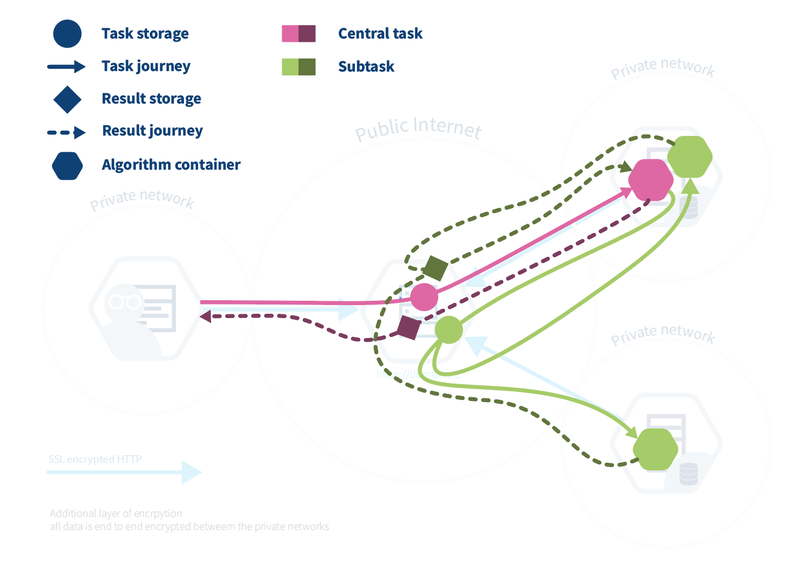Introduction#
In many research projects, data is distributed across multiple organizations. This makes it difficult to perform analyses that require data from multiple sources, as the data owners don’t want to share their data with others. Vantage6 is a platform that enables privacy-enhancing analyses on distributed data. It allows organizations to collaborate on analyses while only sharing aggregated results, not the raw data.
As a user, you can use vantage6 to run your algorithms on sensitive data. In order to create the tasks to run your algorithms, it will be helpful to understand how vantage6 works. In order to help you understand this, we will first explain the basic architecture of vantage6, followed by a description of the resources that are available in vantage6. Using those concepts, we will explain give an example of a simple algorithm and explain how that is run within vantage6.
Vantage6 components#
In vantage6, a client can pose a question to the central server. Each organization with sensitive data contributes one node to the network. The nodes collects the research question from the server and fetches the algorithm to answer it. When the algorithm completes, the node sends the aggregated results back to the server.
The roles of these vantage6 components are as follows:
A (central) server coordinates communication with clients and nodes. The server tracks the status of the computation requests and handles administrative functions such as authentication and authorization.
Node(s) have access to data and execute algorithms
Clients (i.e. users or applications) request computations from the nodes via the client
Algorithms are scripts that are run on the sensitive data. Each algorithm is packaged in a Docker image; the node pulls the image from a Docker registry and runs it on the local data. Note that the node owner can control which algorithms are allowed to run on their data.
On a technical level, vantage6 may be seen as a (Docker) container orchestration tool for privacy preserving analyses. It deploys a network of containerized applications that together ensure insights can be exchanged without sharing record-level data.
Vantage6 resources#
There are several entities in vantage6, such as users, organizations, tasks, etc. These entities are created by users that have sufficient permission to do so and are stored in a database that is managed by the central server. This process ensures that the right people have the right access to the right actions, and that organizations can only collaborate with each other if they agree to do so.
The following statements and the figure below should help you understand their relationships.
A collaboration is a collection of one or more organizations.
For each collaboration, each participating organization needs a node to compute tasks. When a collaboration is created, accounts are also created for the nodes so that they can securely communicate with the server.
Collaborations can contain studies. A study is a subset of organizations from the collaboration that are involved in a specific research question. By setting up studies, it can be easier to send tasks to a subset of the organizations in a collaboration and to keep track of the results of these analyses.
Each organization has zero or more users who can perform certain actions.
The permissions of the user are defined by the assigned rules.
It is possible to collect multiple rules into a role, which can also be assigned to a user.
Users can create tasks for one or more organizations within a collaboration. Tasks lead to the execution of the algorithms.
A task should produce an algorithm run for each organization involved in the task. The results are part of such an algorithm run.
The following schema is a simplified version of the database. A 1-n relationship means that the entity on the left side of the relationship can have multiple entities on the right side. For instance, a single organization can have multiple vantage6 users, but a single user always belongs to one organization. There is one 0-n relationship between roles and organizations, since a role can be coupled to an organization, but it doesn’t have to be. An n-n relationship is a many-to-many relationship: for instance, a collaboration can contain multiple organizations, and an organization can participate in multiple collaborations.
A simple federated average algorithm#
To compute an average, you usually sum all the values and divide them by the number of values. In Python, this can be done as follows:
x = [1,2,3,4,5]
average = sum(x) / len(x)
In a federated data set the values for x are distributed over multiple locations. Let’s assume x is split into two parties:
a = [1,2,3]
b = [4,5]
In this case we can compute the average as:
average = (sum(a) + sum(b))/(len(a) + len(b))
The goal is to compute the average without sharing the individual numbers. In the case of an average algorithm, each node therefore shares only the sum and the number of elements in the dataset. The server then computes the average by summing the sums and dividing by the sum of the number of elements. This way, the individual numbers are never shared.
How to run the algorithm in vantage6#
The average algorithm explained above can be separated in a central part and a federated part. The federated part uses the data to compute the sum and the number of elements. The central part is the aggregation of these results. In order to do so, it is also responsible to start the federated parts and to collecting their results. Note that for more complex algorithms, this can be an iterative process: the central part can send new tasks to the federated parts based on the results of the previous round of federated tasks.

Fig. 1 Common task hierarchy in vantage6. The user (left) creates a task for the central part of the algorithm (pink hexagon). The central part creates subtasks for the federated parts (green hexagons). When the subtasks are finished, the central part collects the results and computes the final result, which is then available to the user.#
Now, let’s see how this works in vantage6. It is easy to confuse the central server with the central part of the algorithm: the server is the central part of the infrastructure but not the place where the central part of the algorithm is executed (Fig. 2). The central part is actually executed at one of the nodes, because it gives more flexibility: for instance, an algorithm may need heavy compute resources to do the aggregation, and it is better to do this at a node that has these resources rather than having to upgrade the server whenever a new algorithm needs more resources.

Fig. 2 The flow of the average algorithm in vantage6. The user creates a task for the central part of the algorithm. This is registered at the server, and leads to the creation of a central algorithm container on one of the nodes. The central algorithm then creates subtasks for the federated parts of the algorithm, which again are registered at the server. All nodes for which the subtask is intended start their work by executing the federated part of the algorithm. The nodes send the results back to the server, from where they are picked up by the central algorithm. The central algorithm then computes the final result and sends it to the server, where the user can retrieve it.#
Note that is also possible for the user to create the subtasks directly, and to compute the central part of the algorithm themselves. This is however not the most common approach as it is in general easier to let the central algorithm do the work.
Running your own algorithms#
Of course, the average algorithm is just an example. In practice, you can run many other algorithms in vantage6. The only requirement is that you package the algorithm in a Docker image that vantage6 can run. The focus of vantage6 is on setting up an infrastructure to run algorithms on sensitive data and ensuring that the data is kept private - the algorithm implementation is kept highly flexible.
The freedom in defining the code also allows you to use federated learning libraries such as PySyft, TensorFlow or Flower within your vantage6 algorithm. Also, it is not only possible to run federated algorithms, but also MPC algorithms or other protocols.
Note
Vantage6 tries to limit the definition of algorithms as little as possible. This means that within a project, it should be established which algorithms are allowed to run on the nodes. Review of this code - or trust in persons that have created the algorithm - is the responsibility of each node owner. They are ultimately in control over which algorithms are run on their data.
Vantage6 is designed to be as flexible as possible, so you can use any programming language and any libraries you like. Python is the most common language to use within the vantage6 community, and also has the most tools available to help you with your work.